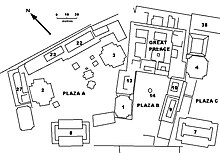Iximché
Iximché is an abandoned center of cult and rule of the Cakchiquel - Maya in the highlands of Guatemala . It is - before Q'umarkaj and Mixco Viejo - the most important and best preserved or best restored temple and palace city of the highland Maya. The name Iximché means "corn tree", after a plant ( Brosimum alicastrum ) that provided food in times of need.
location
Iximché is located on a wooded mountain plateau at an altitude of about 2270 m, surrounded on three sides by ravines, so that it was easy to defend the complex . The archaeological site is located about 2.5 km south of the small town of Tecpán and about 90 km west of the state capital Guatemala City . It is another 50 km to the west to Sololá and Lake Atitlan . The ruins belong to the Chimaltenango department and can be easily reached via an asphalt road from the Panamericana (CA1).
history
The highlands of Guatemala were ruled for many years by the Quiché , the Cakchiquel and the Tzutuhil . In the second half of the 15th century there were permanent conflicts, especially between the formerly allied Quiché and the Cakchiquel, which forced the latter to withdraw to what is now the Chimaltenango Department. Here they founded their new capital, Iximché, around 1470. After the arrival of the Spaniards under the leadership of Hernan Cortez in central Mexico in 1519, the Aztecs had sent messages to their allies or to the tribes they had subjugated; After the defeat of the Aztecs in 1521, the Cakchiquel in turn sent a message to Cortez and asked for help against their enemies, the Quiché.
Under the leadership of Pedro de Alvarado , the Quiché were defeated in the spring of 1524; their leader Tecun Uman was killed. The Cakchiquel then invited the Spaniards to visit Iximché; the Spaniards stayed only a short time - with their newly won Indian auxiliaries they turned west to put down new revolts of the Quiché and Tzutuhil. In July 1524 they returned and founded their capital Tecpán Quauhtemallán ("Forest Palace") near Iximché , from which the name Guatemala probably derives. Because of the Spaniards' greed for gold, uprisings of the indigenous peoples soon followed, but a short time later they withdrew to the mountains, whereupon the Spaniards declared war on them and set Iximché on fire. In 1526 (?) The Spaniards founded a second capital at Tecpan; but already in November 1527 they decided to build the new capital Santiago de los Caballeros de Guatemala , today's Antigua Guatemala . But even after the Spaniards withdrew, the Cakchiquel never returned to their former capital.
Rediscovery
The place was probably never completely forgotten by the indigenous population; the first mention in European sources comes from the year 1695. In the 19th century several European and American researchers visited the site, including John Lloyd Stephens and his draftsman Frederick Catherwood , who, however, did not make or publish a drawing of Iximché. Since 1940, but especially in the 1970s, the ruins have been restored and partially reconstructed.
architecture
The cult and palace center consists of around 20 larger structures, including four courtyards or squares, four temple pyramids , two ball playgrounds and several palace buildings - mostly only preserved in their foundations. The pyramids, constructed in the Talud-tablero system by Teotihuacán , have staircases on two or three sides with wide marginal zones; this makes the corners of the actual pyramid core appear to have been stepped back. The temples themselves, possibly made of wood, have all disappeared. In the past, all buildings were probably covered with stucco and painted; some traces of paint (red, yellow and blue) were discovered. Stone sculptures or stucco reliefs, as they are characteristic of the Maya lowlands (e.g. Copán , Quiriguá , Palenque , Tikal and others), very probably did not exist among the highland Maya. The round structure in place B is interpreted as a sacrificial platform; in it the grave of a nobleman or priest prince was discovered with three companions.
literature
- George F. Guillemín: Iximché: Capital del Antiguo Reino Cakchiquel. Guatemala: Tipografía Nacional de Guatemala, 1965 (Spanish)
- George F. Guillemín: The Ancient Cakchiquel Capital of Iximche. Expedition (University of Pennsylvania Museum of Archeology and Anthropology): pp. 22-35, ISSN 0014-4738 . OCLC 1568625 . ( Online ; PDF; 3.0 MB)
- Linda Schele , Peter Mathews: The Code of Kings - The language of seven Maya temples and tombs. Simon & Schuster, New York: 1999, ISBN 978-0-684-85209-6 . OCLC 41423034 . (English)
- Stephen L. Whittington, David Reed: Evidencia de Dieta y Salud en los Esqueletos de Iximché. Mesoamérica (Antigua Guatemala: El Centro de Investigaciones Regionales de Mesoamérica (CIRMA) in conjunction with Plumsock Mesoamerican Studies, South Woodstock, VT) 35, 1998, pp. 73-82, ISSN 0252-9963 . OCLC 7141215 . (Spanish)
Web links
Coordinates: 14 ° 44 ′ 8.9 ″ N , 90 ° 59 ′ 46.3 ″ W.



